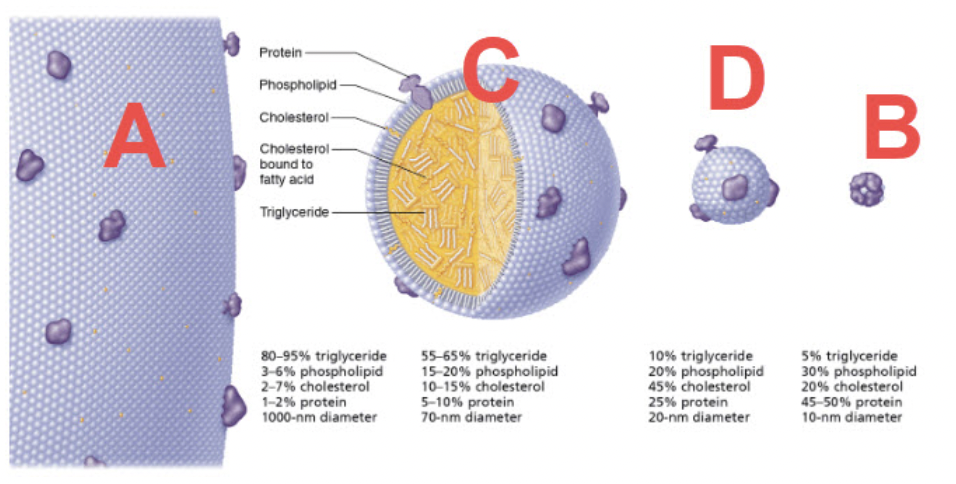
Using your knowledge of the percentage of triglyceride and protein in each lipoprotein, identify the lipoprotein type in “C.”
- HDL
- LDL
- Chylomicron
- VLDL
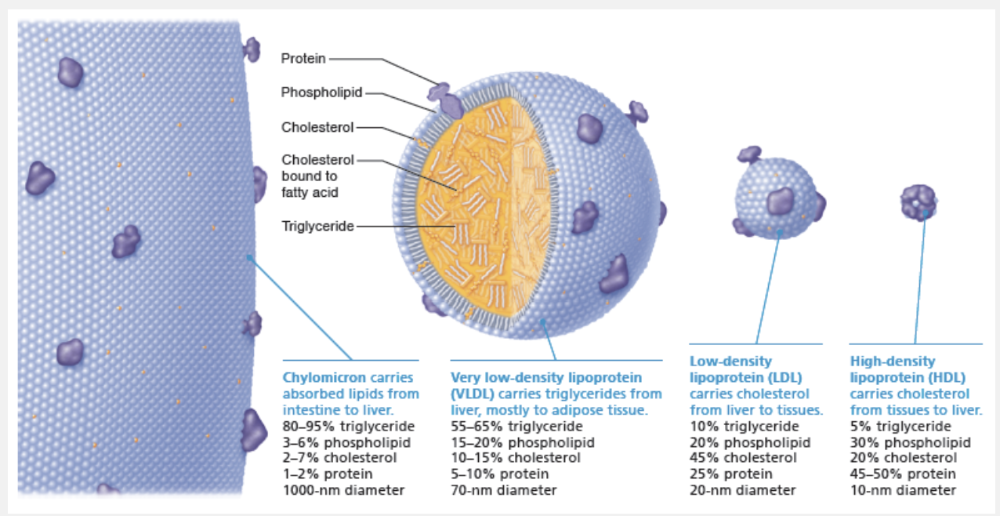
VLDL
Ex.
The lipoprotein with the second greatest amount of triglyceride and the second least amount of protein is the VLDL. Thus, “C” is the VLDL.
In the postabsorptive state, __________.
- insulin serves as the main regulatory hormone
- anabolism exceeds catabolism
- glycogen is broken down to release glucose
- glucose is the only energy source
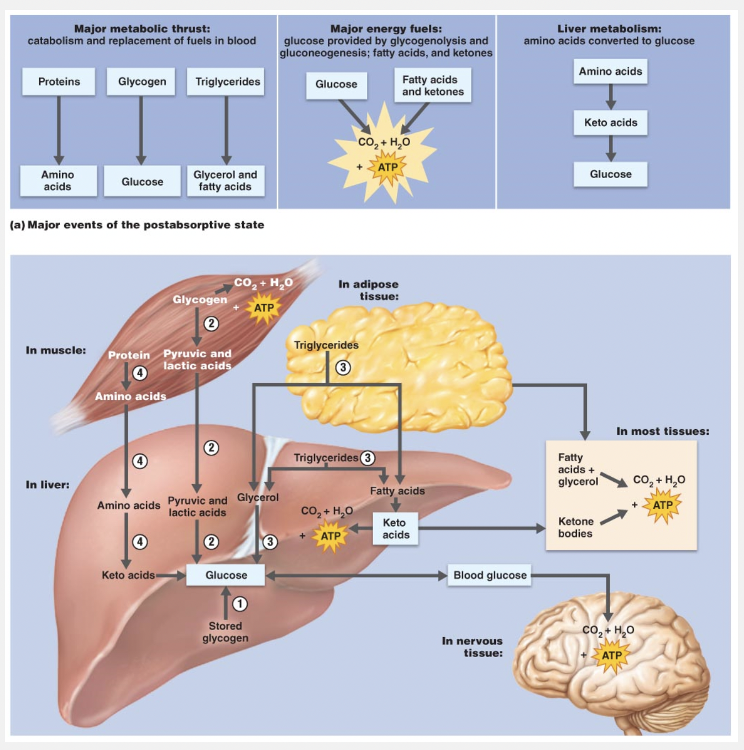
glycogen is broken down to release glucose
Ex.
In the post-absorptive state, glycogen is broken down to release glucose.
So where does blood glucose come from in the post-absorptive state? Sources include stored glycogen in the liver and skeletal muscles, tissue proteins, and, in limited amounts, fats.
The liver’s glycogen stores (about 100 g) are the first line of glucose reserves. They are mobilized quickly by glycogenolysis and can maintain blood sugar levels for about four hours during the post-absorptive state.

Using your knowledge of the percentage of triglyceride and protein in each lipoprotein, identify the lipoprotein type in “A.”
- HDL
- LDL
- Chylomicron
- VLDL

Chylomicron
Ex.
The lipoprotein with the greatest amount of triglyceride and the least amount of protein is the chylomicron. Thus, “A” is the chylomicron.
A major means for conserving heat in the body is __________.
- increased convective loss
- vasoconstriction of cutaneous blood vessels
- vasodilation of cutaneous blood vessels
- decreased metabolic rate
- enhanced sweating
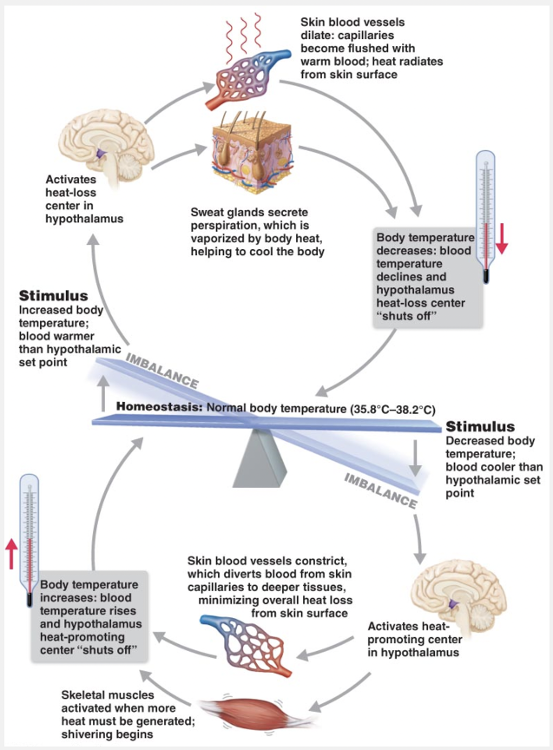
vasoconstriction of cutaneous blood vessels
Ex.
A major means for conserving heat in the body is vasoconstriction of cutaneous blood vessels.
When the external temperature is low or blood temperature falls for any reason, the heat-promoting center is activated. It triggers one or more of the following mechanisms to maintain or increase core body temperature.
Activation of the sympathetic vasoconstrictor fibers serving the blood vessels of the skin causes strong vasoconstriction of cutaneous blood vessels. This restricts blood to deep body areas and largely bypasses the skin. Because a layer of insulating subcutaneous (fatty) tissue separates the skin from deeper organs, this reduces heat loss from the shell dramatically and lowers shell temperature toward that of the external environment.
Which of the following is considered a long-term regulator of feeding behavior?
- Stimulation of stretch receptors
- Leptin levels
- Cholecystokinin (CCK) levels
- Blood concentrations of amino acids and fatty acids
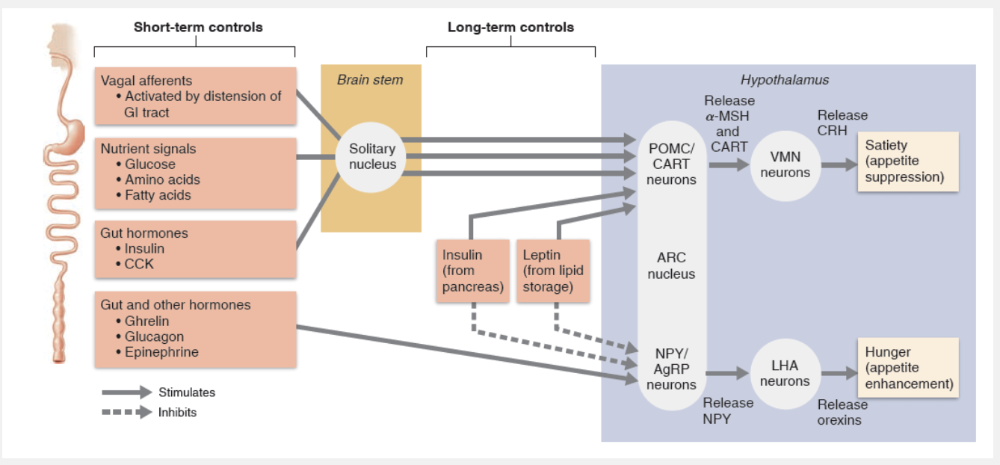
Leptin levels
Ex.
Leptin levels is considered a long-term regulator of feeding behavior.
A key component of the long-term controls of feeding behavior is the hormone leptin (“thin”). Secreted exclusively by adipose cells in response to an increase in body fat mass, leptin indicates the body’s total energy stores in fat tissue. (Thus adipose tissue acts as a “Fat-o-Stat” that sends chemical messages to the brain in the form of leptin.)
When levels of leptin rise in the blood, it binds to receptors in the arcuate nucleus (ARC) in the hypothalamus that specifically (1) suppress the release of neuropeptide Y and (2) stimulate the expression of CART. NPY is the most potent appetite stimulant known. By blocking its release, leptin prevents the release of the appetite-enhancing orexins from the lateral hypothalamic area (LHA). This decreases appetite and food intake, eventually promoting weight loss.
When fat stores shrink, leptin blood levels drop, an event that exerts opposite effects on the two sets of ARC neurons. Consequently, appetite and food intake increase, and (eventually) weight gain occurs.
Initially it seemed that leptin was the magic bullet that obesity researchers were looking for, but their hopes were soon dashed. Rising leptin levels do promote weight loss, but only to a certain point. Furthermore, individuals who are obese have higher-than-normal leptin blood levels, but for some unknown reason, they are resistant to its action. Now the consensus is that leptin’s main role is to protect against weight loss in times of nutritional deprivation.
Although leptin has received the most attention as a long-term appetite and metabolism regulator, there are several other players. Insulin, like leptin, inhibits NPY release in non-insulin-resistant individuals, but its effect is less potent.
A form of malnutrition in which children frequently develop a bloated abdomen is called _____________.
- pica
- browning reaction
- kwashiorkor
- marasmus
kwashiorkor
Ex.
Kwashiorkor is caused by proportionately lower protein intake than calories in children. It is characterized by a bloated abdomen (edema) because the amount of plasma proteins is inadequate to keep fluid in the bloodstream. Skin lesions and infections are likely.
Marasmus, caused by inadequate overall calorie intake, results in weight loss and depletion of fat and muscle.
Pica is craving and eating nonfood substances such as clay or dirt.
Browning reactions are non-enzymatic reactions between glucose and proteins that are thought to toughen proteins in the body as we age.
A genetic disorder in which the enzyme to convert a particular amino acid to tyrosine is called __________________.
- marasmus
- pica
- kwashiorkor
- phenylketonuria
phenylketonuria
Ex.
A genetic disorder in which the enzyme to convert a particular amino acid to tyrosine is called phenylketonuria.
There are many inborn errors of metabolism (or genetic disorders), but one of the most common is phenylketonuria (PKU). In PKU, tissue cells are unable to use the amino acid phenylalanine, which is present in all protein foods. The enzyme that converts phenylalanine to tyrosine is defective.
Kwashiorkor is caused by a low protein intake in children.
Marasmus is caused by an inadequate overall calorie intake.
Pica is a craving for, and eating of, nonfood substances such as clay or dirt.
A function of the liver during the postabsorptive state is __________.
- electron transport to release glucose
- glycolysis
- to store excess glucose by glycogenesis
- lipogenesis
- to mobilize glucose reserves by glycogenolysis

to mobilize glucose reserves by glycogenolysis
Ex.
A function of the liver during the post-absorptive state is to mobilize glucose reserves by glycogenolysis.
So where does blood glucose come from in the post-absorptive state? Sources include stored glycogen in the liver and skeletal muscles, tissue proteins, and, in limited amounts, fats.
- Glycogenolysis in the liver. The liver’s glycogen stores (about 100 g) are the first line of glucose reserves. They are mobilized quickly and can maintain blood sugar levels for about four hours during the post-absorptive state.
- Glycogenolysis in skeletal muscle. Glycogen stores in skeletal muscle are approximately equal to those of the liver. Before liver glycogen is exhausted, glycogenolysis begins in skeletal muscle (and to a lesser extent in other tissues). However, the glucose produced is not released to the blood because, unlike the liver, skeletal muscle lacks the enzymes needed to dephosphorylate glucose. Instead, glucose is partly oxidized to pyruvic acid (or, during anaerobic conditions, lactic acid), which enters the blood, is reconverted to glucose by the liver, and is released to the blood again.
- Lipolysis in adipose tissues and the liver. Adipose and liver cells produce glycerol by lipolysis, and the liver converts the glycerol to glucose (gluconeogenesis) and releases it to the blood. Because acetyl CoA, a product of the beta oxidation of fatty acids, is produced beyond the reversible steps of glycolysis, fatty acids cannot be used to bolster blood glucose levels.
- Catabolism of cellular protein. Tissue proteins become the major source of blood glucose during prolonged fasting when glycogen and fat stores are nearly exhausted. Cellular amino acids are deaminated and converted to glucose in the liver. During fasts lasting several weeks, the kidneys also carry out gluconeogenesis and contribute as much glucose to the blood as the liver.
In these situations, the body sets priorities. Muscle proteins are the first to be catabolized. Movement is not nearly as important as maintaining wound healing and the immune response. Of course there are limits to the amount of tissue protein that can be catabolized before the body stops functioning. The heart is almost entirely muscle protein, and when it is severely catabolized, the result is death. In general, the amount of fat the body contains determines the time a person can survive without food.
Which of the following is not part of the metabolic syndrome?
- An increased waist circumference
- Increased blood glucose
- Decreased blood pressure
- Decreasesd blood HDL cholesterol
- Increased blood triglycerides
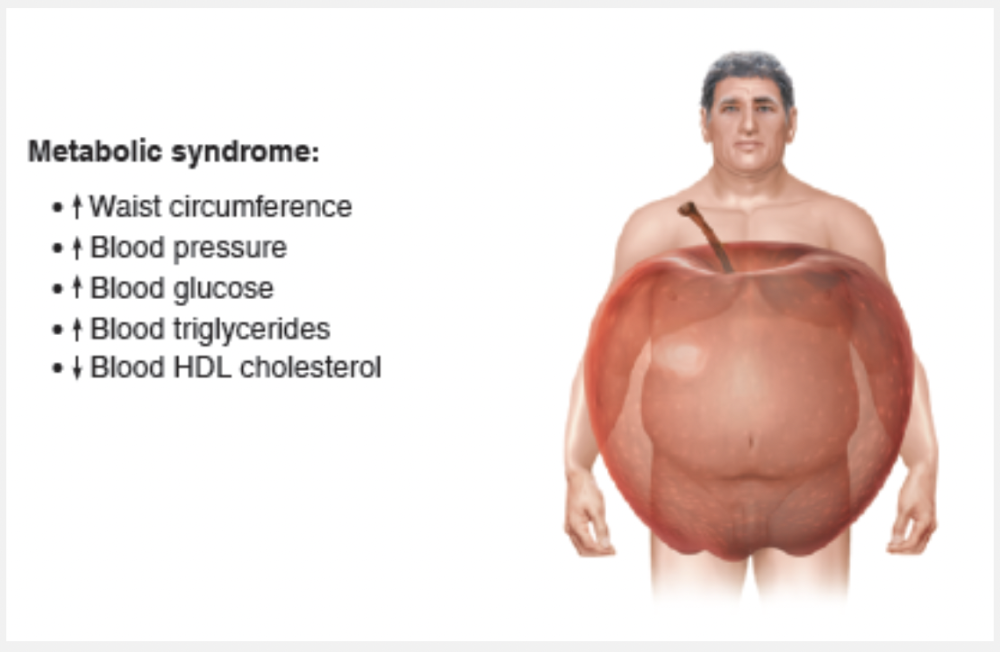
Decreased blood pressure
Ex.
Decreased blood pressure is not part of the metabolic syndrome.
Metabolic syndrome is defined as a cluster of five risk factors. Together, they double the chance of getting heart disease and stroke, and increase the chance of developing type 2 diabetes by five times. About 32% of the U.S. population has the dubious distinction of qualifying for this syndrome by having three of the five risk factors.
Metabolic syndrome reflects abnormal adipose tissue function, and visceral fat in the abdominal cavity is particularly susceptible. Increased visceral fat (as in the cavity is particula is associated with increased inflammatory cytokines and insulin resistance, which contribute to elevated blood glucose and triglycerides, and the development of atherosclerosis. On the other hand, subcutaneous fat (as in the y cyto body shape where fat is deposited in the hips) is less susceptible to dysfunction.
Which lipoprotein contains high levels of cholesterol?
- HDL
- Chylomicron
- LDL
- VLDL
- IDL
LDL
Ex.
LDL contains high levels of cholesterol.
Most cells other than liver and intestinal cells obtain the bulk of the cholesterol they need for membrane synthesis from the blood. When a cell needs cholesterol, it makes membrane receptor proteins for LDL. LDL binds to the receptors, is engulfed by endocytosis, and the endocytotic vesicles fuse with lysosomes, where the cholesterol is freed for use. When excessive cholesterol accumulates in a cell, it inhibits both the cell’s own cholesterol synthesis and its synthesis of LDL receptors.
HDLs are considered "good" cholesterol and high blood levels of this cholesterol are thought to be beneficial since they transport excess cholesterol from peripheral tissues to the liver, where it is broken down and becomes part of bile.
Factors other than diet also influence blood cholesterol levels. For example, cigarette smoking and stress lower HDL levels, whereas regular aerobic exercise and estrogen lower LDL levels and increase HDL levels. Interestingly, body shape provides clues to risky blood levels of cholesterol and fats. “Apples” (people with upper body and abdominal fat, seen more often in men) tend to have higher levels of cholesterol and LDLs than “pears” (whose fat is localized in the hips and thighs, a pattern more common in women).
VLDLs transport triglycerides from the liver to peripheral (nonliver) tissues, mostly to adipose tissue.
Chylomicrons are lipoproteins that transport fats from the intestines into the blood during absorption of nutrients.
The thermoregulatory centers are located in the __________.
- liver
- mitochondrion
- hypothalamus
- thymus gland
- spinal cord
hypothalamus
Ex.
The thermoregulatory centers are located in the hypothalamus.
Although other brain regions contribute, the hypothalamus, particularly its anterior region is the main integrating center for thermoregulation. Together the heat-loss center (located more anteriorly) and the heat-promoting center make up the brain’s thermoregulatory centers.
The hypothalamus receives afferent input from (1) peripheral thermoreceptors located in the shell (the skin), and (2) central thermoreceptors sensitive to blood temperature and located in the body core including the anterior portion of the hypothalamus. Much like a thermostat, the hypothalamus responds to this input by reflexively initiating appropriate heat-promoting or heat-loss activities.
The central thermoreceptors have more influence than the peripheral ones, but varying inputs from the shell probably alert the hypothalamus to the need to prevent temperature changes in the core. In other words, they allow the hypothalamus to anticipate changes to be made.
In the absorptive state, __________.
- fats are the main energy fuel
- catabolism exceeds anabolism
- insulin serves as the main regulatory hormone
- glycogen is broken down to release glucose
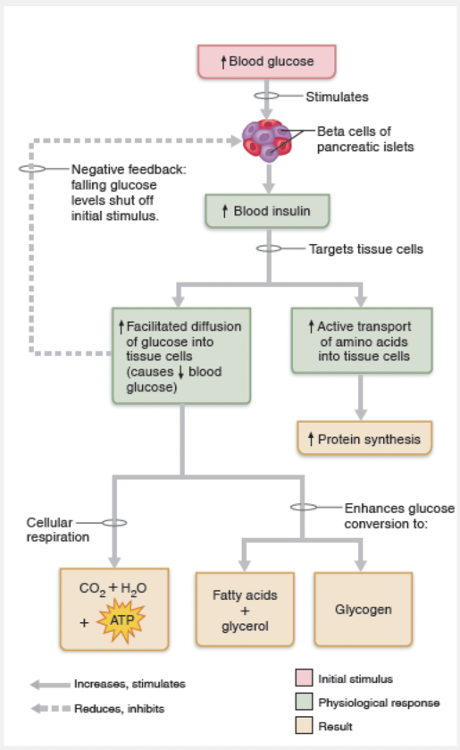
insulin serves as the main regulatory hormone
Ex.
In the absorptive state, insulin serves as the main regulatory hormone.
Insulin directs essentially all events of the absorptive state. After a meal, rising blood glucose and amino acid levels stimulate the beta cells of the pancreatic islets to secrete more insulin. The GI tract hormone glucose-dependent insulinotropic peptide (GIP) and parasympathetic stimulation also promote the release of insulin.
Additional Learning:
Insulin binds to membrane receptors of its target cells. This stimulates the translocation of the glucose transporter to the plasma membrane, which enhances the carrier-mediated facilitated diffusion of glucose into those cells. Within minutes, the rate of glucose entry into tissue cells (particularly muscle and adipose cells) increases about 20-fold. The exception is brain and liver cells, which take up glucose whether or not insulin is present.
Once glucose enters tissue cells, insulin enhances glucose oxidation for energy and stimulates its conversion to glycogen and, in adipose tissue, to triglycerides. Insulin also “revs up” the active transport of amino acids into cells, promotes protein synthesis, and inhibits liver export of glucose and virtually all liver enzymes that promote gluconeogenesis.
As you can see, insulin is a hypoglycemic hormone (hi″pogli- se′mik). It sweeps glucose out of the blood into tissue cells, lowering blood glucose levels. It also enhances glucose oxidation or storage while inhibiting any process that might raise blood glucose levels.
__________ acts to suppress appetite by inhibiting __________, which is the most-powerful known appetite stimulant.
- Leptin; neuropeptide Y
- Insulin; glucagon
- Growth hormone; lipase
- Serotonin; adrenaline

Leptin; neuropeptide Y
Ex.
Leptin acts to suppress appetite by inhibiting neuropeptide Y, which is the mostpowerful appetite stimulant known.
When levels of leptin rise in the blood, it binds to receptors in the arcuate nucleus (ARC) in the hypothalamus that specifically (1) suppress the release of neuropeptide Y and (2) stimulate the expression of CART. NPY is the most potent appetite stimulant known. By blocking its release, leptin prevents the release of the appetite-enhancing orexins from the lateral hypothalamic area (LHA). This decreases appetite and food intake, eventually promoting weight loss.

Using your knowledge of the percentage of triglyceride and protein in each lipoprotein, identify the lipoprotein type in “D.”
- HDL
- LDL
- VLDL
- Chylomicron

LDL
Ex.
The lipoprotein with second to least amount of triglycieride and is second in the amount of protein is the LDL. Thus, “D” is LDL.

Using your knowledge of the percentage of triglyceride and protein in each lipoprotein, identify the lipoprotein type in “B.”
- Chylomicron
- VLDL
- HDL
- LDL

HDL
Ex.
The lipoprotein with the least amount of triclyceride and the greatest amount of protein is the HDL. Thus, “B” is HDL.
The hormone that controls essentially all events of the absorptive state is __________.
- insulin
- thyroxine
- glucagon
- ADH
- calcitonin

insulin
Ex.
The hormone that controls essentially all events of the absorptive state is insulin.
Insulin directs essentially all events of the absorptive state. After a meal, rising blood glucose and amino acid levels stimulate the beta cells of the pancreatic islets to secrete more insulin. The GI tract hormone glucose-dependent insulinotropic peptide (GIP) and parasympathetic stimulation also promote the release of insulin.
Additional Learning:
Insulin binds to membrane receptors of its target cells. This stimulates the translocation of the glucose transporter to the plasma membrane, which enhances the carrier-mediated facilitated diffusion of glucose into those cells. Within minutes, the rate of glucose entry into tissue cells (particularly muscle and adipose cells) increases about 20-fold. The exception is brain and liver cells, which take up glucose whether or not insulin is present.
Once glucose enters tissue cells, insulin enhances glucose oxidation for energy and stimulates its conversion to glycogen and, in adipose tissue, to triglycerides. Insulin also “revs up” the active transport of amino acids into cells, promotes protein synthesis, and inhibits liver export of glucose and virtually all liver enzymes that promote gluconeogenesis.
As you can see, insulin is a hypoglycemic hormone (hi″pogli- se′mik). It sweeps glucose out of the blood into tissue cells, lowering blood glucose levels. It also enhances glucose oxidation or storage while inhibiting any process that might raise blood glucose levels.
Which of the following would raise body temperature?
- Sweating
- Thyroxine
- Evaporation
- Dilation of cutaneous blood vessels
Thyroxine
Ex.
Thyroxine would raise body temperature.
The amount of thyroxine produced by the thyroid gland is probably the most important hormonal factor in determining BMR. For this reason, thyroxine has been dubbed the “metabolic hormone.” Its direct effect on most body cells (except brain cells) is to increase O2 consumption and heat production, in part by accelerating the use of ATP to operate the sodium-potassium pump. As ATP reserves decline, cellular respiration accelerates. Thus, the more thyroxine produced, the higher the BMR.
The official medical measurement of obesity is the __________.
- body mass index
- basal metabolic rate
- proportion of bone density to weight
- proportion of LDLs to body weight
body mass index
Ex.
The official medical measurement of obesity is the body mass index.
Body mass index (BMI) is a formula for determining obesity based on a person's weight relative to height. To estimate BMI, multiply weight in pounds by 705 and then divide by your height in inches squared: BMI = (wt (lb) X 705)/height (inches)2.
Overweight is defined by a BMI between 25 and 30 and carries some health risk. Obesity is a BMI greater than 30 and has a markedly increased health risk.
A body fat content of 18–20% of body weight (males and females respectively) is deemed normal for adults.
However it’s defined, obesity is perplexing and poorly understood, and the economic toll of obesity-related disease is staggering. Chronic low-grade systemic inflammation accompanies obesity and contributes to insulin resistance and type 2 diabetes mellitus. People who are obese also have a higher incidence of atherosclerosis, hypertension, heart disease, and osteoarthritis.
The U.S. is big and getting bigger, at least around its middle. Two out of three adults are overweight, one out of three is obese, and one in twelve has diabetes. U.S. kids are getting fatter too: 20 years ago, 5% were overweight; today over 15% are and more are headed that way.
Which of the following factors makes it harder for an obese person to lose weight?
- An increase in taste receptors
- An increase in metabolism that increases appetite
- An increase in alpha-adrenergic receptors (the kind that favors fat accumulation) in fat cells
- An increase in thyroxine levels as fat levels accumulate
- An increase in heat loss from the body that requires more food intake
An increase in alpha-adrenergic receptors (the kind that favors fat accumulation) in fat cells
Ex.
An increase in alpha-adrenergic receptors (the kind that favors fat accumulation) in fat cells makes it harder for an obese person to lose weight.
Obese people are more fuel efficient and more effective “fat storers.” Although it is often assumed that people who are obese eat more, this is not necessarily true—many actually eat less than people of normal weight. When yo-yo dieters lose weight, their metabolic rate falls sharply. But, when they subsequently gain weight, their metabolic rate temporarily increases like a furnace being stoked. Each successive weight loss occurs more slowly, but they regain weight faster. To make matters worse, “fat” fat cells of overweight people:
- Sprout more alpha-adrenergic receptors, which favor fat accumulation.
- Send different molecular messages than “thin” fat cells. They spew out inflammatory cytokines that can promote insulin resistance and they release less adiponectin, a hormone that improves the action of insulin in glucose uptake and storage.
- Have exceptionally efficient lipoprotein lipases, which unload fat from the blood (usually to fat cells).
Frostbite occurs because of ___________.
- enhanced sweating during cold weather
- prolonged vasoconstriction of cutaneous blood vessels in cold temperatures
- a loss of the ability to shiver
- a decreased metabolic rate
prolonged vasoconstriction of cutaneous blood vessels in cold temperatures
Ex.
Frostbite occurs because of prolonged vasoconstriction of cutaneous blood vessels in cold temperatures.
Restricting blood flow to the skin is not a problem for a brief period. If it is prolonged (as during exposure to very cold weather), the lack of heat transfer can lead to the formation of ice crystals in and around cells, causing them to die. This extremely serious condition is frostbite.
A kilocalorie is the amount of energy __________.
- locked up in 1 kilogram of water
- needed to move 1 kilogram of water 1 meter
- needed to heat 1 kilogram of water 1 degree Fahrenheit
- needed to heat 1 kilogram of water 1 degree Celsius
needed to heat 1 kilogram of water 1 degree Celsius
Ex.
A kilocalorie is the amount of energy needed to heat 1 kilogram of water 1 degree Celsius.
The energy value of foods is measured in kilocalories (kcal). One kilocalorie is the amount of heat energy needed to raise the temperature of 1 kilogram of water 1°C (1.8°F). This unit is the “calorie” (C) that dieters count so conscientiously.
__________ are considered "good" cholesterol; high blood levels of this cholesterol are thought to be beneficial.
- Chylomicrons
- HDLs
- LDLs
- VLDLs
HDLs
Ex.
HDLs are considered "good" cholesterol; high blood levels of this cholesterol are thought to be beneficial.
The major function of HDLs, which are particularly rich in phospholipids and proteins, is to scoop up and transport excess cholesterol from peripheral tissues to the liver, where it is broken down and becomes part of bile. The liver makes the protein envelopes of the HDL particles and then ejects them into the bloodstream in collapsed form, rather like deflated beach balls.
Once in the blood, these still-incomplete HDL particles fill with cholesterol picked up from tissue cells and “pulled” from artery walls. HDL also provides the steroid-producing organs, like the ovaries and adrenal glands, with their raw material (cholesterol).
As a rule, high levels of HDLs are considered good because the transported cholesterol is destined for degradation (think H for healthy). HDL levels above 60 mg/dl are thought to protect against heart disease, and levels below 40 are considered undesirable. In the United States, HDL levels average 40–50 in males and 50–60 in women.
High LDL levels (160 mg/dl or above) are considered bad (think L for lousy) because when LDLs are excessive, potentially lethal cholesterol deposits are laid down in the artery walls. The goal for LDL levels is 100 or less. A good rule of thumb is that HDL levels can’t be too high and LDL levels can’t be too low.
VLDLs transport triglycerides from the liver to peripheral (nonliver) tissues, mostly to adipose tissue.
Chylomicrons are lipoproteins that transport fats from the intestines into the blood during absorption of nutrients.